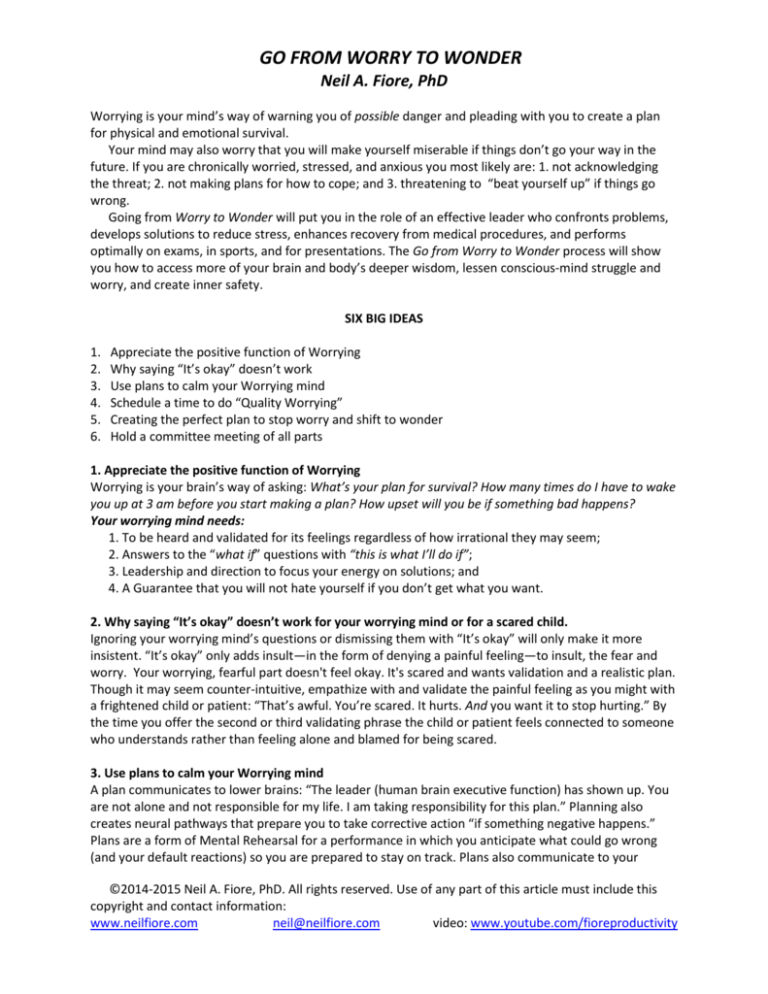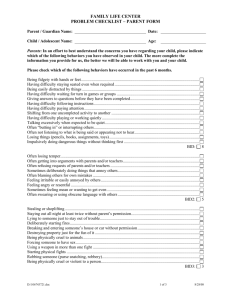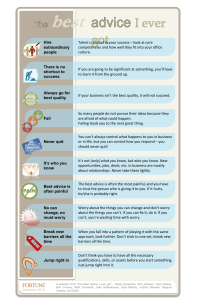
GO FROM WORRY TO WONDER
Neil A. Fiore, PhD
Worrying is your mind’s way of warning you of possible danger and pleading with you to create a plan
for physical and emotional survival.
Your mind may also worry that you will make yourself miserable if things don’t go your way in the
future. If you are chronically worried, stressed, and anxious you most likely are: 1. not acknowledging
the threat; 2. not making plans for how to cope; and 3. threatening to “beat yourself up” if things go
wrong.
Going from Worry to Wonder will put you in the role of an effective leader who confronts problems,
develops solutions to reduce stress, enhances recovery from medical procedures, and performs
optimally on exams, in sports, and for presentations. The Go from Worry to Wonder process will show
you how to access more of your brain and body’s deeper wisdom, lessen conscious-mind struggle and
worry, and create inner safety.
SIX BIG IDEAS
1.
2.
3.
4.
5.
6.
Appreciate the positive function of Worrying
Why saying “It’s okay” doesn’t work
Use plans to calm your Worrying mind
Schedule a time to do “Quality Worrying”
Creating the perfect plan to stop worry and shift to wonder
Hold a committee meeting of all parts
1. Appreciate the positive function of Worrying
Worrying is your brain’s way of asking: What’s your plan for survival? How many times do I have to wake
you up at 3 am before you start making a plan? How upset will you be if something bad happens?
Your worrying mind needs:
1. To be heard and validated for its feelings regardless of how irrational they may seem;
2. Answers to the “what if” questions with “this is what I’ll do if”;
3. Leadership and direction to focus your energy on solutions; and
4. A Guarantee that you will not hate yourself if you don’t get what you want.
2. Why saying “It’s okay” doesn’t work for your worrying mind or for a scared child.
Ignoring your worrying mind’s questions or dismissing them with “It’s okay” will only make it more
insistent. “It’s okay” only adds insult—in the form of denying a painful feeling—to insult, the fear and
worry. Your worrying, fearful part doesn't feel okay. It's scared and wants validation and a realistic plan.
Though it may seem counter-intuitive, empathize with and validate the painful feeling as you might with
a frightened child or patient: “That’s awful. You’re scared. It hurts. And you want it to stop hurting.” By
the time you offer the second or third validating phrase the child or patient feels connected to someone
who understands rather than feeling alone and blamed for being scared.
3. Use plans to calm your Worrying mind
A plan communicates to lower brains: “The leader (human brain executive function) has shown up. You
are not alone and not responsible for my life. I am taking responsibility for this plan.” Planning also
creates neural pathways that prepare you to take corrective action “if something negative happens.”
Plans are a form of Mental Rehearsal for a performance in which you anticipate what could go wrong
(and your default reactions) so you are prepared to stay on track. Plans also communicate to your
©2014-2015 Neil A. Fiore, PhD. All rights reserved. Use of any part of this article must include this
copyright and contact information:
www.neilfiore.com
neil@neilfiore.com
video: www.youtube.com/fioreproductivity
Worrying Mind that you are paying attention to its concerns and are stepping up to take action, allowing
this survival function to turn down the volume on its screaming.
4. Schedule a Time to do “Quality Worrying”
Instead of worrying every hour, all day long, schedule a time to do some quality worrying. Set aside a
few minutes at a specific time to answer all the "what if" questions with a plan that says "This is what I'll
do if that happens." Instead of trying to ignore potential problems, do a mental rehearsal of how to face
and deal with your worst fears and most persistent worries. Setting a time for “quality worrying” shuts
off worrying during the day and allows you time to focus and develop effective plans.
5. Creating the perfect plan to stop worry and shift to Wonder
The ultimate or overarching plan guarantees: “Regardless of what happens, your worth is safe with me. I
will not make you feel bad. I will not turn against you just because something went wrong.”
Your perfect plan for survival maintains a solid sense of worth regardless of what happens. It answers
the “what if” questions with “even if the worst happens; even if they turn against you, I’m on your side; I
will not make you feel bad.”
What is your plan for making yourself safe with you? How many worries would disappear if you could
guarantee that—regardless of what happens—you would forgive yourself and accept yourself?
Remember that accepting yourself as a human being, who cannot control everything, is the ultimate
plan that integrates and quiets your worrying mind.
6. Hold a Committee meeting of all the “Yes, buts”
Call all your worrying thoughts to a meeting in which you finally show up as the chairperson. Invite all
their “what if” and “yes, but” questions. No holding back. Honor each worry with a “Yes that would be
awful. Here’s what we’ll do if that happens.” Offer a realistic—not a falsely positive—mental rehearsal
of what you’d experience, how you’d react, who you’d call for help, what you’d do, and how you’d feel
after confronting the negative event or loss.
You as an adult with an evolved human brain have knowledge and skills that were not available to
you when childhood worries were formed or when lower brains held onto primitive methods of survival.
You, in the current world environment, with your advanced tools, can override old, outdated fears and
limited ways of coping. You as the chairperson can accept responsibility for your decision to put aside
old fears in favor of bold actions that have a greater promise of success in today’s world.
Remind yourself and your committee that you will forgive yourself for being vulnerable to loss and
disappointment; then reassert your commitment to accepting yourself (and all parts of you) as a normal
human being.
EXERCISE: Go from Worry to Wonder in one breath
Release worry, anxiety, and frustration in five seconds by taking a deep breath and exhaling as you give
that energy to your body to work on the troubling issue. When you notice that you’re worrying, you
might also notice that you’re tightening muscles in your forehead or jaw. This means you’re working
with just your consciously controlled muscles and the relatively small part of your brain.
To release this tension and worry: tighten your muscles further and include your fists and biceps as
you inhale and hold your breath for a few seconds; release your muscles and your worry with a big
exhalation to increase oxygen and blood supply to your body; and shift to wondering about what your
body and your genius brain can do with the extra energy you just released.
If the worry returns, hold it for just five seconds—that’s one breath—before tensing and releasing it
to wonder.
Say “This will be interesting” to evoke a creative solution. Ask yourself, “What can I do now?”
©2014-2015 Neil A. Fiore, PhD. All rights reserved. Use of any part of this article must include this
copyright and contact information:
www.neilfiore.com
neil@neilfiore.com
video: www.youtube.com/fioreproductivity









